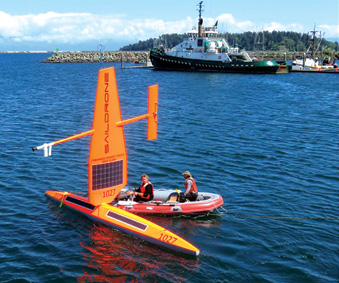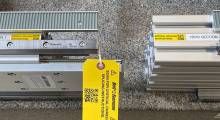The International Robotic Sailing Regatta (SailBot) is a robotic sailing competition held in North America in which teams of university, college and high school students compete. The first event, in 2006, was hosted by Queen’s University in Kingston, Ontario, and took inspiration from a successful senior project at the University of British Columbia that built a robotic sailboat.
Since 2008 teams have annually competed throughout the U.S. and Canada, traveling from as far away as Europe and Brazil. The goal is to create an unmanned sailboat that navigates through a variety of challenges with limited, if any, human control.
Students use this friendly competition between schools to apply their engineering knowledge in a multi-disciplinary task that requires mechanical, electrical, software and engineering management skills to deal with this highly variable environment.

Ken Stafford is a professor of Robotics Engineering and Mechanical Engineering, and serves as the director of the Robotics Resource Center at Worcester Polytechnic Institute in Worcester, MA.
We spoke to him to gain insight into this year’s annual SailBot Competition. Here’s how our conversation went.
Digital Engineering: Can you provide an overview of the SailBot competition, how it came to be and the intent of the program? How many participants have you had or are you expecting?
Ken Stafford: The competition is oriented to boats competing in the SailBot Class (up to 2 meters in length) but smaller boats are popular due to their easier logistics. There is an Open Class (which are boats up to 4 meters in length) oriented toward non-school teams.
Occasionally boats above 2 meters in length enter in preparation for the MicroTransAt Challenge (max 2.4 meters length) or the World Robotics Sailing Championship (up to 4 meters in length). Many teams use the MaxiMOOP as their first platform due to its convenient size of 1.2 m lightweight of20 kg,, greater payload capability than an remote-controlled boat and improved seaworthiness.
This year we have confirmed teams coming from Queen’s University and Memorial University from Canada, plus Virginia Polytechnic Institute, Cornell University and Worcester Polytechnic Institute from the U.S.. We also have three high school teams from Newburyport High School, MA and Broadneck High School, MD. We also have possible entrants from Olin College and Egypt. Over the previous 12 years of competition the number of entrants ranged from three to 15.
DE: Can you tell us about some of the designs that are part of the event and how they came to be?
Stafford: Recently, the designs have focused on sloop-rigged monohulls (single-masted, single-hulled boats with main and jib sails) meeting the SailBot class rules (under 2 meters in overall length). There have been a variety of different configurations over the years, however, including trimarans, “open class” (up to 4 meters long), and a few 1.2-meter boats meeting the “maxiMOOP” class rules.
This competition stresses control and seaworthiness over speed so most of the classic radio-controlled sailboat hulls are a poor fit. Throughout the years, there have also been a variety of non-traditional sails, i.e., “rigid wing-sails,” used. There will be at least two entries with wing-sails this year. Wing-sails have the potential for higher performance and lower battery use to operate, but are much more challenging to build well and generally result in a less stable and adaptable boat.
DE: Can you provide some examples of what the event has produced or what you expect it to produce?
Stafford: As an educator, I am thrilled that this competition has consistently produced opportunities for students to combine their rigorous academic disciplines with the maker aspects of craftsmanship and robustness. It continues to be a real challenge in terms of software development, sensor integration, control algorithms, aerodynamics, hydrodynamics, structural analysis and system integration. Over the three years I’ve been involved I’ve seen innovations such as canting keels, above-water movable ballast, ultrasonic wind measurement and camera/GPS integration. So while the point is not so much to produce some radical new boat design as it is to exercise the engineering process to solving these challenges, there have been incremental innovations that could be implemented on ocean drones.
DE: Does WPI, or the consortium of organizers of this competition, have a particular stance on adopting an innovation that is linked to the program? What drives firms to sponsor the event and coordinate it?
Stafford: WPI does not have any authority or expectation to capitalize on any of the non-WPI student designs. While there has been external sponsorship interest/support in certain years, the events at WPI have been solely supported and funded by WPI’s Robotics Resource Center. As America’s first university to offer a BS in robotics engineering, we support all things robotic and have been thrilled to have these teams and creations associated with our school. My personal interest comes from my dual passions of sailing and robots!
DE: Anything else you’d like to tell us about the event?
Stafford: Over the years, the event has expanded from basic general sailing challenges such as short- and long-course racing, and navigation accuracy demonstrated both along a course and by staying in a confined area with a judged technical presentation to incrementally more complex events. There are now eight separate evaluated challenges that include: the Presentation, a Fleet Race, a 7-hour autonomous Endurance/Long Distance Race, a Station-Keeping Challenge, a Precision Navigation Challenge, a Payload-carrying Challenge, a Collision-Avoidance Challenge and a Search and Discover Challenge. All but the Fleet Race and Payload-carrying Challenges are intended to be accomplished fully autonomously.
Interestingly enough, the Station-keeping and Search and Discovery Challenges have direct applicability to several start-up companies. One company has designed a fleet of sailing robots that navigate to a certain ocean position then simply stay in that area collecting environmental data until told to return. Large commercial freight haulers are looking into deployable unmanned rescue craft that could find overboard sailors. As with most good academic projects, there actually is valuable and appropriate practical research going on.
About the Author
Follow Robotics 24/7 on Linkedin
Article topics
Email Sign Up















